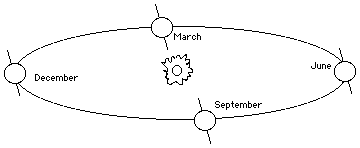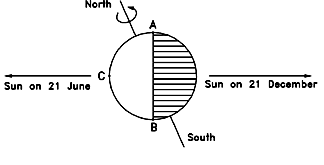On the equator (point C) the sun would always rise until it was overhead, while at the poles (A and B) it would always be on the horizon, going around the horizon once a day. Each point on Earth would be carried around once a day, along the lines drawn: the dark parts of the lines, to the right of line AB, would have daylight, and the lightly drawn parts would be on the nightside and in shadow. Because everything is symmetric with respect to the line AB, the dark and light portions are always equal, and so are day and night, anywhere on Earth.
Equinox and Solstice

In particular (drawing above), the angle between the Earth's axis and the Earth-Sun line changes throughout the year. Twice a year, at the spring and fall equinox (around March 21 and September 23--the exact date may vary a bit) the two directions are perpendicular.
Twice a year, the angle is as big as it can get, at the summer and winter solstices, when it reaches 23.5 degrees. In the summer solstice (around June 21) the north pole is inclined towards the Sun, in the winter solstice (around December 21) it faces away from it.
Let us look at the summer solstice first, with the Sun on the left.

Summer and Winter
The boundary AB between sunlight and shadow--between day and night--is always perpendicular to the Earth-Sun line, as it was in the example shown at the beginning.
But now, as each point on Earth is carried on its daily trip around the rotating Earth, the thick (day part) and light (night part) of the trip are not at all equal. North of the equator, day is longer than night, and when we get close enough to the north pole, there is no night at all. The Sun is then always above the horizon and it just makes a 360-degree circuit around it. That part of Earth enjoys summer.
A mirror-image situation exists south of the equator: nights are longer than days, and the further one gets from the equator, the larger is the imbalance--until one gets so close to the pole that the sun never rises. That is the famous arctic night, with 24 hours of darkness each day. In that half of the Earth, it is winter time.
Half a year later, the Earth is on the other side of the Sun, that is, the Sun's position should be as drawn on the left. The Earth's axis however has not moved, but is still pointed to the same patch of sky, near the star Polaris.
Now the thick lines should represent night and the thin ones day, the south pole is bathed in constant sunshine and the north one is dark. Summer and winter have switched hemispheres.
 A big difference between summer and winter is thus the length of the days: note that on the equator that length does not change, and hence Spring, Summer, Fall, and Winter do not exist there (depending on weather patterns, however, there may exist a "wet season" and a "dry season"). In addition (as the drawing makes clear), the Sun's rays hit the summer hemisphere more vertically than the winter one, and that, too, helps heat the ground.
A big difference between summer and winter is thus the length of the days: note that on the equator that length does not change, and hence Spring, Summer, Fall, and Winter do not exist there (depending on weather patterns, however, there may exist a "wet season" and a "dry season"). In addition (as the drawing makes clear), the Sun's rays hit the summer hemisphere more vertically than the winter one, and that, too, helps heat the ground.
At equinox, the situation is as in the first drawing, and night and day are equal (that's where the word "equinox" comes from)
Some interesting facts
If June 21 is the day when we receive the most sunshine, why is it regarded as the beginning of summer and not its peak? And similarly, why is December 21, the day of least sunshine, the beginning of winter and not mid-winter day?
Blame the oceans, which heat up and cool down only slowly. By June 21 they are still cool from the winter time, and that delays the peak heat by about a month and a half. Similarly, in December the water still holds warmth from the summer, and the coldest days are still (on the average--not always! ) a month and a half ahead.
And what about our distance from the Sun? It, too, varies, because the Earth's orbit around the Sun isn't an exact circle. We are closest to the Sun--would you believe it? --in the cold wintertime, around January 3-5. This may have an interesting implication for the ice ages, as will be explained later.